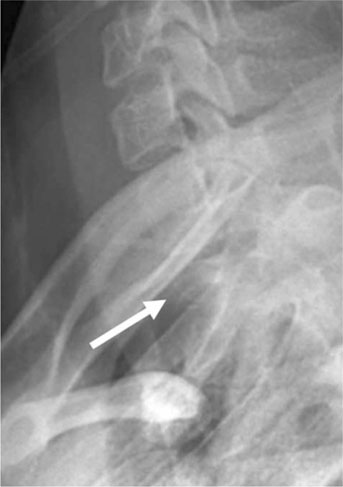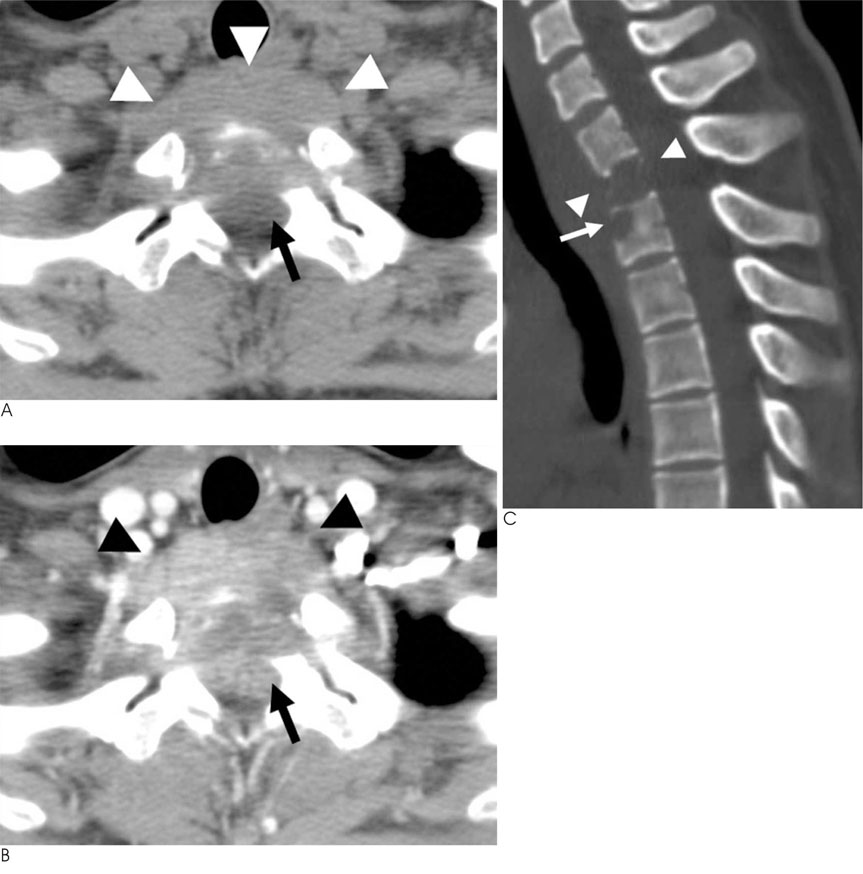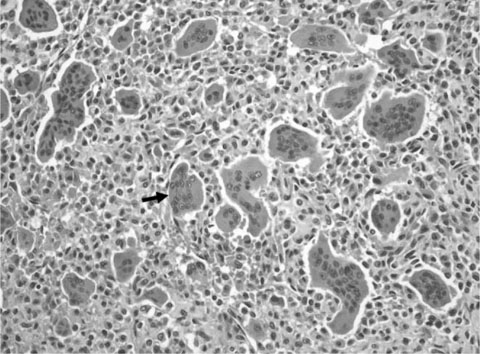J Korean Soc Radiol.
2010 Jun;62(6):579-583.
Vertebra Plana Caused by a Giant Cell Tumor: A Case Report and Literature Review
- Affiliations
-
- 1Department of Radiology, Soonchunhyang University Bucheon Hospital, Korea. mj4907@schbc.ac.kr
- 2Department of Neurosurgery, Soonchunhyang University Bucheon Hospital, Korea.
- 3Department of Pathology, Soonchunhyang University Bucheon Hospital, Korea.
Abstract
- We report here on the case of a 19-year-old woman who presented with progressive weakness of the lower extremities. The radiographs and CT showed vertebra plana of the first thoracic vertebral body. The mass had low signal intensity on the T1-weighted MR image and intermediate signal intensity on the T2-weighted MR image, and this low signal intensity extended to the spinal canal. Histological examination revealed a giant cell tumor (GCT). MR imaging is the imaging modality of choice for helping to distinguish spinal GCT from other spinal tumors by defining the extent and characteristic signal intensity of the tumor.
MeSH Terms
Figure
Reference
-
1. Baghaie M, Gillet P, Dondelinger RF, Flandroy P. Vertebra plana: Benign or malignant lesion? Pediatr Radiol. 1996; 26:431–433.2. Papagelopoulos PJ, Currier BL, Galanis E, Grubb MJ, Pritchard DJ, Ebersold MJ. Vertebra plana caused by primary ewing sarcoma: case report and review of the literature. J Spinal Disord Tech. 2002; 15:252–257.3. Rodallec MH, Feydy A, Larousserie F, Anract P, Campagna R, Babinet A, et al. Diagnostic imaging of solitary tumors of the spine: What to do and say. Radiographics. 2008; 28:1019–1041.4. Murphey MD, Nomikos GC, Flemming DJ, Gannon FH, Temple HT, Kransdorf MJ. From the archives of AFIP. Imaging of giant cell tumor and giant cell reparative granuloma of bone: radiologicpathologic correlation. Radiographics. 2001; 21:1283–1309.5. Hart RA, Boriani S, Biagini R, Currier B, Weinstein JN. A system for surgical staging and management of spine tumors. A clinical outcome study of giant cell tumors of the spine. Spine. 1997; 22:1773–1782.6. Sakurai H, Mitsuhashi N, Hayakawa K, Niibe H. Giant cell tumor of the thoracic spine simulating mediastinal neoplasm. AJNR Am J Neuroradiol. 1999; 20:1723–1726.7. Johnson S, Klostermeier T, Weinstein A. Case report 768. Eosinophilic granuloma of the cervical spine. Skeletal Radiol. 1993; 22:63–65.8. Sanjay BK, Sim FH, Unni KK, McLeod RA, Klassen RA. Giant-cell tumours of the spine. J Bone Joint Surg Br. 1993; 75:148–154.9. Kwon JW, Chung HW, Cho EY, Hong SH, Choi SH, Yoon YC, et al. MRI findings of giant cell tumors of the spine. AJR Am J Roentgenol. 2007; 189:246–250.10. Bidwell JK, Young JW, Khalluff E. Giant cell tumor of the spine: computed tomography appearance and review of the literature. J Comput Tomogr. 1987; 11:307–311.
- Full Text Links
- Actions
-
Cited
- CITED
-
- Close
- Share
- Similar articles
-
- Giant Cell Tumor Involving the Sixth Cervical Spine: One Case Report
- A Case of the Giant-Cell Tumor in Coccyx
- A Giant Cell Tumor of the Lumbar Vertebra: One Case Report
- Total Spondylectomy for Giant Cell Tumor of Cervical Spine
- Tenosynovial Giant Cell Tumor Showing Severe Bone Erosion in the Finger: Case Report and Review of the Imaging Findings and Their Significance





